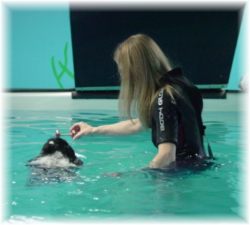Swim therapy
When a beloved pet gets seriously injured or requires orthopedic surgery, you may be facing a long road to recovery; many weeks of healing followed by many more weeks of reconditioning are possible and quite likely. Complete recovery may not always be possible, but the ideal of course, is to attain the best level of recovery with a return to as many activities as were done previously. Owners naturally hope for the best and want to do everything they can to help but may not know what they can do or where to start.
One year I had the misfortune of one of my older Havanese requiring surgery. At 10&1/2 years old, we were faced with a ruptured Anterior Cruciate Ligament (ACL) and torn cartilage. As a very high-drive active performance dog, so we chose surgery as the best option for her. I spent countless sleepless nights worrying about what the future would hold. I was convinced that our days of training and competition were over; all I hoped for was that she recovered sufficiently to still enjoy the things she enjoyed most in life. One thing against her of course was her age; however there were many more things in her favour; she was lean, muscular and in top condition. I was surprised and cautiously optimistic when our orthopedic Vet offered an excellent prognosis. The most optimistic outcome was a full recovery to allow her to continue in any and all previous activities, including training and perhaps competing again. But achieving that very best outcome was going to take some work on my part.
A dog will naturally protect an injured body part and may hold it tucked in close to their body. This is a natural response, but if permitted throughout the healing process, a limb can then heal in an unnatural position, or can have tightened ligaments which restrict range of motion resulting in a limp or other loss of mobility. In our case, that meant carefully structured exercises including physiotherapy starting just 24 hours post surgery. I became an expert in passive range of motion exercises, stretches and massage techniques. These would promote correct healing and ensure the widest range of motion possible. Was it enough? Could I do any more?
 As I delved into researching post surgery recovery techniques, the one thing that came up
regularly was the
benefits of swimming. With our Vet's approval we chose to add hydrotherapy to our recovery
program. My
10 year old Havanese had never been exposed to water, so it was with hope but also some
trepidation that
we went off to swim therapy. I had nothing to worry about. At her first exposure, she walked
straight down
the ramp right into the pool and started swimming. Years ago, I ran across some Havanese notes
that
indicated Havanese are avid swimmers and can swim like little seals if raised near water. It's
one of those
interesting little tidbits of information that had gone by the wayside. All Havanese may not have
this love
of water, but this one certainly does.
As I delved into researching post surgery recovery techniques, the one thing that came up
regularly was the
benefits of swimming. With our Vet's approval we chose to add hydrotherapy to our recovery
program. My
10 year old Havanese had never been exposed to water, so it was with hope but also some
trepidation that
we went off to swim therapy. I had nothing to worry about. At her first exposure, she walked
straight down
the ramp right into the pool and started swimming. Years ago, I ran across some Havanese notes
that
indicated Havanese are avid swimmers and can swim like little seals if raised near water. It's
one of those
interesting little tidbits of information that had gone by the wayside. All Havanese may not have
this love
of water, but this one certainly does.
Swimming is a non weight bearing activity which may improve flexibility and help to rebuild
muscle tone and
strength while minimizing stain to injured or sore areas. Because of the buoyancy, there are less
risks and
limitations than other forms of exercise which means that more exercise may be able to be done
sooner in
a recovery program. An experienced trainer develops a program suitable to the dog's age, injury
and level
of recovery and works the dog in individual assisted swim sessions. Many methods may be used,
building
on the dog's natural abilities and aptitudes. In our case, seeing as I had an avid retriever, the
program
included water retrieves with a special floating dumbbell. At first, the swim laps were very short
with plenty
of resting in between. Our trainer also used small floats for support which gradually were
removed as my
recovering dog got stronger. After a few sessions, she was swimming well and getting noticeably
stronger
with little limitation of movement. Week after week, the Vet was delighted her progress. At the
two month
mark, we were a couple of weeks ahead of the expected improvement. Note: 6 months post surgery Mitzi was back in the agility ring enjoying one of her favorite
activities.
While swim therapy may not be right for all dogs and all instances, I am confident that in our case, swimming is what made the difference. Not only did it accelerate recovery, it also helped to achieve the highest level of recovery possible. Hydrotherapy may be one of many assorted options to optimize the healing process and help an injured pet recover good health and function.
In my 25 years of owning Havanese, I have had three dogs undergo patella or cruciate surgery. Each time, swim therapy has been part of the recovery and reconditioning process and we have been very happy with the positive results and good recoveries.